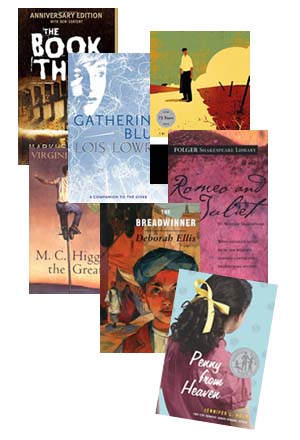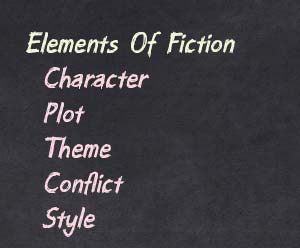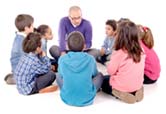
One of the most common questions I get asked is, "How long should a novel unit be?". After writing literature lesson plans for almost 30 years, I'm still surprised at how each book always presents its own set of circumstances that influence how the novel unit will be written.
The Basic Novel Unit: Reading and Comprehending
When creating a novel unit, I generally try to keep reading assignments less than thirty pages each for middle and high school students and twenty pages or less for upper elementary and intermediate school students. The number of pages per reading assignment and the length of the book will be the primary factors in determining the length of time needed for your basic novel unit.
For each reading assignment, you will need to determine whether the reading will be done in-class or at home. For in-class reading assignments, you'll need to determine if reading will be done silently or orally, individually or in groups. I like to use combinations of all of these variables throughout a unit of study to give students the opportunity to practice each kind of reading. For example, different skills are required for oral reading versus silent reading and reading at home versus reading in class. Home presents different distractions than the classroom does. Reading orally in front of a whole class is different from reading with a favorite partner or friend. Mixing up the variables exposes students to many different reading situations and helps to develop well-rounded skills.
On the most basic level, students will need to read the book and show to you that they understand what they have read. That means you'll need comprehension questions or some other way to determine whether or not they have read and understand the assignments.
You will likely need to address vocabulary in some way. Whether you choose potentially problematic vocabulary words from the text or have students keep a list of words in the text that they don't know, there will undoubtedly be vocabulary that needs to be dealt with so students can understand the story to its fullest.
So, you will need to schedule reading assignments, comprehension assessment, and vocabulary study at least.
Beyond The Basics: Elements of Fiction

The next block of study usually added to a novel unit is related to the elements of fiction: setting, plot, characters, conflict, theme, tone, and perhaps historical context. Delving into these elements gives students the opportunity to develop some analytical and critical thinking skills--and helps students more fully engage with the meaning of the novel. Students have to go beyond basic comprehension to look at the characters and events with both macro and micro vision. For example, where does this story fit in the big picture of its historical context? Or conversely, what exactly is it that causes a character to do or say a particular thing? Discussing each of the elements of fiction as it relates to the novel at hand provides a framework for a number of lessons and activities. The exact number really depends on how deeply you want students to dig and how capable your students are of analytical work.
Language Arts Skills: Reading, Writing, and Thinking in Response to Literature

Using a novel as a foundation of content with which to apply and practice language arts skills is common practice. It will add a significant amount of time to your novel unit, but many teachers believe this is time well-spent.
A well-written novel provides abundant opportunities to look at word usage, examples of figurative language, sentence structures, and the construction of suspense or humor in the story. A close reading of the way an author uses words and constructs the novel--words, sentences, paragraphs, chapters--helps students see how language can and should be used purposefully. Studying examples and then practicing emulating them in written or oral work, group work, or whole-class participation helps students' written and oral language skills grow.
As students discuss characters and themes, conflicts, allusions, and ideas presented within the novel, you have the opportunity to elicit responses from students on a big variety of things, in both written and oral forms. When writing letters or emails from one character to another, for example, student not only have to understand both characters, they need to know how to communicate as one of the characters AND how to express that in the appropriate format. There are literally hundreds of writing assignment and role-playing activity possibilities for any single novel: letters, journals, research papers, poems, presentations, skits, essays, videos--the list is practically endless.
With endless possibilities, how do you decide which things to include in your novel study? After all, it's unlikely you can spend months on one book--and you shouldn't even if you could. Each book students read provides its own set of questions and discoveries, opportunities for learning, and challenges. To determine what to include in your novel unit, you have to step back and consider three broad things: your curriculum objectives, the makeup of the book itself, and the needs/abilities of your particular students. These three things together will help you determine where to focus your language arts skills lessons and activities. Some books just naturally lend themselves to one thing more than another. A book like Huckleberry Finn, with lots of slang dialogue gives you the unique opportunity to discuss regional dialects and how they are constructed as well as "translating" them into standard English. On the other hand, one of Charles Dickens' novels would be filled with great examples of descriptive writing and character development. Maybe your students are already great at writing descriptive compositions. If so, you could concentrate on something else. You really have to look at the book, your students, and your curriculum to determine how to best spend your lesson and activity time.
Putting It All Together
Teaching is an art, not a science; there is no formula that fits every situation. You have to be the professional person who can weigh the elements involved and craft an appropriate plan. Even after you craft a plan for teaching a book once, the same formula won't necessarily hold for the next book you teach--or even the next time you teach the same book. In a given school year you need to cover a certain number of books which each lend themselves to different experiences for your students--choosing books, lessons, and activities that advance the development of your particular students within your particular curriculum. Start with the Basic Novel Unit and add the lessons and activities that will most effectively teach your students, using the best of what that book or author has to offer.

